Despite having attended hundreds of tradeshows over the years, I really did not know what to expect from DEMA 2008, held October 22-25 at the Las Vegas Convention Center in Las Vegas. This was the 32nd gathering of the Diving Equipment & Marketing Association, and a massive one at that, with over 600 exhibitors filling the South Hall of the giant Las Vegas Convention Center. For me, it was my first. DEMA, of course, seeks to support and promote diving-related businesses, and their promotional efforts include the "Be A Diver" campaign, all sorts of marketing help, and, as each year's climax, the annual DEMA show. Despite uncertain economic times, DEMA was a smashing success.
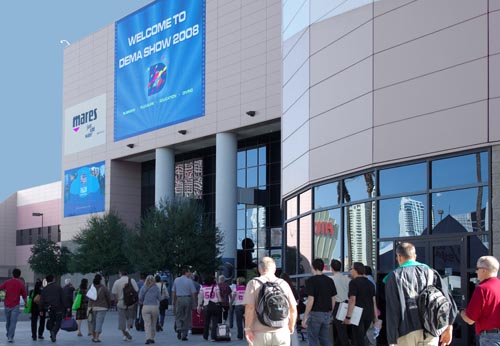
Initially, I didn't know if we were going to make it, but Event PR goddess Patricia Rowan of Adams Unlimited had come through with us delinquent folks who registered much too late. I feel guilty for having pestered her for press credentials at such a late date, but consummate professional that she is, Patricia made things happen. Thank you Patricia and Donna!
In the press room I saw Women Divers Hall of Famer Jill Heinerth of Rebreather Pro and simply had to say hi to her. A couple of weeks ago I had again watched the movie "The Cave," an underwater thriller where she and her business partner provided high definition video and technical assistance with the rebreathers. Jill is among the world's premier rebreather experts and it was great meeting her in person. She is also an awesome photographer and you can see Jill Heinerth's work on SmugMug.
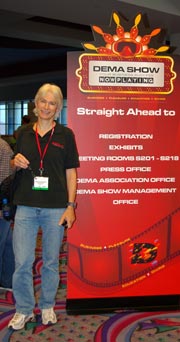 The show itself was huge, extremely well laid out, and presented in an interesting manner. This is actually more difficult than it sounds. I've been to shows that were simply boring due to an uninspired layout, the wrong mix of vendors, isles that were too wide or narrow, and other glitches. At DEMA 2008, everything was just right. Traffic flowed, there was enough space, no one crowded out anyone else, and things were distributed nicely. There was a wide main drag down the middle of the very long South Hall, from which you had quick access to just about everything through cross alleys. There were no dead areas, and nothing was remote. Whoever designed the layout and mix of vendors did a bang-up job.
The show itself was huge, extremely well laid out, and presented in an interesting manner. This is actually more difficult than it sounds. I've been to shows that were simply boring due to an uninspired layout, the wrong mix of vendors, isles that were too wide or narrow, and other glitches. At DEMA 2008, everything was just right. Traffic flowed, there was enough space, no one crowded out anyone else, and things were distributed nicely. There was a wide main drag down the middle of the very long South Hall, from which you had quick access to just about everything through cross alleys. There were no dead areas, and nothing was remote. Whoever designed the layout and mix of vendors did a bang-up job.
As I was taking pictures from the entrance area I was told there was no picturetaking at DEMA. Upon seeing my press pass I was allowed to continue. Apparently there's a bit of a problem with industrial espionage where unsavory companies simply photograph all the latest designs and then quickly flood the market with copies. Not nice at all, and I can definitely understand DEMA's concerns. We appreciate that as press we're allowed to pass on to our readers what we see at the show.

I then began meandering around and quickly getting drawn in by all the cool stuff at the show. ScubaDiverInfo's staff photographer and technical editor Carol Cotton saw many old friends from her years of managing Rhea's Dive Shop in Maryville, Tennessee. It can be a small world, and especially so in a closely-knit community like scuba diving.
Right off the bat, for example, we ran into Ed Pemberton from adventureswim.com who hails from Knoxville, Tennessee. Ed is a PADI course director and now involved in, among other things, teaching babies to swim. He told us more than we ever thought possible on how the little tykes swim and dive, and showed us the most amazing products to get babies comfortable underwater, like a flexible mirror to get their attention and make them feel comfortable, little surf boards and other cool stuff. We had a hard time dragging ourselves away. (www.adventureswim.com)
At Innovative Scuba Concepts we saw all the latest scuba related gadgets and accessories imaginable. One product that caught my attention was an air pressure indicator system that hooks to the tank via low pressure hose. It has three banks of very bright LEDs. When the tank is full the green ones are on, then as pressure goes down the orange ones come on and then the red. When pressure drops below 500 psi, the reds are flashing. That way an instructor, or even concerned parents, can see where everyone's air is. Not for everyone, but very clever. (www.innovativescuba.com)
At Bonica, Kenneth Ho, President, demonstrated to us their double-protected video camera. 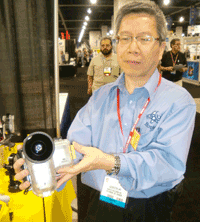 I had seen those online and checked out their website. The camera is an Aiptek unit that is amazingly small and light, yet does superb 720P video at full-motion 30 frames per second speed.
I had seen those online and checked out their website. The camera is an Aiptek unit that is amazingly small and light, yet does superb 720P video at full-motion 30 frames per second speed.
What sets Bonica apart is the ultra-handy and very cleverly engineered and executed housing. The camera is actually double-protected, with a soft inner sleeve that is good for depths down to ten feet, and is also used when the camera goes inside its hard-shell housing for real dives. This way, the camera is protected even in the unlikely case that there is a leak in the outer housing. Overall cost is quite affordable and we've heard nothing but good reports on it. I am not quite sure which Aiptek model is used by Bonica and hope we get a chance to soon take the camera underwater for some serious testing. (www.bonicadive.com)
 Underwater Technologies Center demonstrated their UDI Underwater Digital Interface, a wearable pager type of device that lets divers communicate and message. The unit has a built-in dive computer as well as a 3D compass. The technology is based on a system of networks with each network connecting as many as 14 divers. Very useful and possibly live-saving as the units communicate with the boat as well. (www.utc-digital.com)
Underwater Technologies Center demonstrated their UDI Underwater Digital Interface, a wearable pager type of device that lets divers communicate and message. The unit has a built-in dive computer as well as a 3D compass. The technology is based on a system of networks with each network connecting as many as 14 divers. Very useful and possibly live-saving as the units communicate with the boat as well. (www.utc-digital.com)
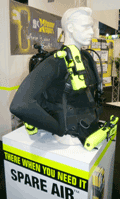 We stopped by our friends at Submersible Systems Inc. where they showed their innovative little SpareAir units with capacities of 1.7 and 3 cu-ft. I know, I know, a lot of divers feel that is not enough to be useful. I am not sure I agree; if I run out of air and no diving buddy is closeby, having another three cubic feet sounds like a very good thing. Or if someone in my group is out of air, I'd rather hand him or her my SpareAir for a safe ascent than messing with the ever-iffy buddy breathing. (www.spareair.com)
We stopped by our friends at Submersible Systems Inc. where they showed their innovative little SpareAir units with capacities of 1.7 and 3 cu-ft. I know, I know, a lot of divers feel that is not enough to be useful. I am not sure I agree; if I run out of air and no diving buddy is closeby, having another three cubic feet sounds like a very good thing. Or if someone in my group is out of air, I'd rather hand him or her my SpareAir for a safe ascent than messing with the ever-iffy buddy breathing. (www.spareair.com)
We said hi to Robert Aston at the Manta Network. At Scubadiverinfo.com we've been supporting their important work of monitoring mantas as well as spreading awareness for years, and their new stationary camera housing looks most impressive. The Manta Network is a 501.c.3 non-profit, though they are also selling OceanCam camera housings and such through Ocean Presence Technologies. We signed up as members. (save-the-mantas.org, www.oceanpresence.com)
 The ReefNet folks showed their interesting Dive Data Recorder. It is a small data logging device that records temperature and depth at a 10-second sampling interval and with incredible accuracy. This way you can store 1500 hours of dive data and then analyze it on your PC or Mac. This could be extremely important for professional divers when reconstructing a dive. I can also see insurance agencies be interested. (www.reefnet.ca)
The ReefNet folks showed their interesting Dive Data Recorder. It is a small data logging device that records temperature and depth at a 10-second sampling interval and with incredible accuracy. This way you can store 1500 hours of dive data and then analyze it on your PC or Mac. This could be extremely important for professional divers when reconstructing a dive. I can also see insurance agencies be interested. (www.reefnet.ca)
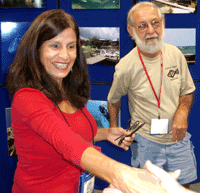 At the large Bay Islands section we stopped by the CoCo View Resort table and said hi to Liz Sanders, the ever-busy coordinator of CoCo View dive trips and travel.
At the large Bay Islands section we stopped by the CoCo View Resort table and said hi to Liz Sanders, the ever-busy coordinator of CoCo View dive trips and travel.
Who should we meet there but the legendary Doc Radawski, the walking encyclopedia of all things Roatan. I well remember Doc's memorable lecture on the history of Roatan, from the time the island was discovered to more recent events. For a detailed description of what the CoCo View resort on Roatan island has to offer, see our ScubaDiverInfo.com CoCo View resort review.
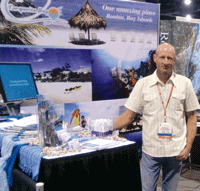 The Bay islands were well represented with dozens of booths from resorts on Roatan and Utila. I truly had no idea there are so many resorts on the Bay Islands. I also found that the dive center at one of them, Turquoise Bay, is run by a fellow Swiss national, Patrick Zingg, so I got a chance to exchange some words in Swiss German. Like many others, Patrick had visited Roatan some ten years ago and fallen in love with the place. To the extent where he now owns Subway Dive Center at the Turquoise dive resort with its 26 air-conditioned rooms and avant-garde decor. Now that is a testimony! (www.turquoisebayresort.com)
The Bay islands were well represented with dozens of booths from resorts on Roatan and Utila. I truly had no idea there are so many resorts on the Bay Islands. I also found that the dive center at one of them, Turquoise Bay, is run by a fellow Swiss national, Patrick Zingg, so I got a chance to exchange some words in Swiss German. Like many others, Patrick had visited Roatan some ten years ago and fallen in love with the place. To the extent where he now owns Subway Dive Center at the Turquoise dive resort with its 26 air-conditioned rooms and avant-garde decor. Now that is a testimony! (www.turquoisebayresort.com)
I personally have always been fascinated with full face masks, and OceanReef's product line is impressive. They've been around for 50 years and they have all the arguments as to why a full face mask makes sense and why it is not just for commercial divers. OceanReef is interested in debunking all the myths about full face masks and present the reasons to dive with a FFM. I am actually almost convinced. New for 2009 are the SDVL Shield Display & Visor Light that shows depth and pressure data via LED banks, and the GSM CUBE 3 underwater communicator that works via wired, wireless or FM. They also showed the Alpha Pro X-Divers underwater communication system for talk between the surface and divers, and the Gamma Alpha audio/video unit that sends video from a diver to the surface. (www.oceanreefgroup.com)
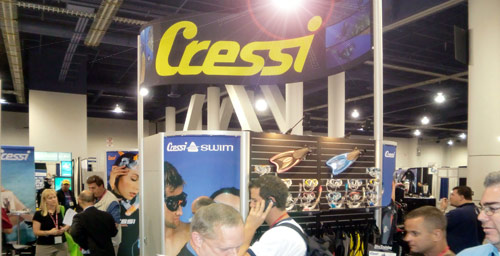
Sometimes it's little things that can make or break a dive, and one of them is a custom mouthpiece from SeaCure. A lot of divers are just fine with a standard mouthpiece but some are not, and I am one of them. At the end of a dive my jaw hurts and I often can barely hold on to the recalcitrant thing. So using one of their SeaCure custom mouthpieces seems like an attractive idea. (www.seacure1.com)
 At NiteRider we saw some of the most attractive and useful dive lights. I was especially intrigued with the Pro Diver II dual halogen light (5w/15w). The big news for 2009 is the upgrade to wet connectors. The neoprene headband and the soft handmount are now included. The Pro Diver II runs on five D cells (or NiCads) and you get up to ten hours on the 5 watt and up to 3.5 hours on the 15-watt bulb. (/www.nightriderdive.com)
At NiteRider we saw some of the most attractive and useful dive lights. I was especially intrigued with the Pro Diver II dual halogen light (5w/15w). The big news for 2009 is the upgrade to wet connectors. The neoprene headband and the soft handmount are now included. The Pro Diver II runs on five D cells (or NiCads) and you get up to ten hours on the 5 watt and up to 3.5 hours on the 15-watt bulb. (/www.nightriderdive.com)
Some really helpful things are simple. Like a camera strap. Yes, after having dropped (and almost lost) more than one of the new small digital cameras during a dive because the wriststrap wasn't tight or because I didn't have one that fit the camera, it was great to find DiveLeash by Leashtec LLC. This handy neoprene wrist strap is absolutely perfect for diving and snorkeling and will pay for itself many times over the first time you do NOT lose a camera because it's securely strapped to your wrist. (www.leashtec.com)
 If you like dive maps you know Franko's maps. Franko's crew was at DEMA and displayed their latest and greatest. Tracey (see picture) showed us around the booth and explained the latest additions to Franko's growing lineup of waterproof, educational and endlessly entertaining maps that not only list and describe every divesite, but also highlight locales and other attractions.
If you like dive maps you know Franko's maps. Franko's crew was at DEMA and displayed their latest and greatest. Tracey (see picture) showed us around the booth and explained the latest additions to Franko's growing lineup of waterproof, educational and endlessly entertaining maps that not only list and describe every divesite, but also highlight locales and other attractions.
Unbeknownst to some, Franko's also has fishing and boating maps, trail maps, surfing maps, creature maps and wreck maps. The maps are printed on durable waterproof synthetic paper using fade-resistant inks, and you can get them either folded or laminated. (www.frankosmaps.com)
Another awesomely cool idea is a scuba museum, and I'd absolutely love to go see the Lockwood Pioneer Scuba Diving Museum in Loves Park, Il. It's done by a non-profit and covers the evolution of diving. The museum is named after James E. Lockwood, an explorer, inventor and entrepreneur who was also a scuba diving pioneer (he invented a diving lung in 1938). (www.lockwoodmuseum.com)
Liquid Image got a LOT of attention after they revealed their Camera Mask at the 2008 CES. Yes, it combines a camera and a scuba mask and looks just too cool. Melanie Pearson explained how they conceived of the idea and then came up with the design. Hint: we ain't seen nothing yet! So keep your eyes peeled. (www.liquidimageco.com)
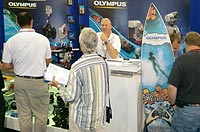 We met with Jeff Hluchyj of Olympus and he showed us their latest in underwater photography. We already knew the Stylus 1030SW which is waterproof down to 33 feet (see our full review of the Olympus 1030SW). Very interesting is the Evolt 520 digital SLR with its impressive housing that looks more compact and user-friendly than prior housings. Olympus is also using a new twist-style locking mechanism instead of the older metal clasps. At the low end, Olympus offers the FE-230 with its own underwater housing, and the whole setup costs only US$279!! The camera itself has three underwater modes. A terrific deal. I also got to talk with John McGuire, the Olympus product manager for underwater cameras and equipment. (olympusamerica.com/cpg_section/oima_underwater.asp)
We met with Jeff Hluchyj of Olympus and he showed us their latest in underwater photography. We already knew the Stylus 1030SW which is waterproof down to 33 feet (see our full review of the Olympus 1030SW). Very interesting is the Evolt 520 digital SLR with its impressive housing that looks more compact and user-friendly than prior housings. Olympus is also using a new twist-style locking mechanism instead of the older metal clasps. At the low end, Olympus offers the FE-230 with its own underwater housing, and the whole setup costs only US$279!! The camera itself has three underwater modes. A terrific deal. I also got to talk with John McGuire, the Olympus product manager for underwater cameras and equipment. (olympusamerica.com/cpg_section/oima_underwater.asp)
SeaLife had a major presence with its award-winning DC800 that's equally at home on land as underwater. Denise hinted at exciting future plans and we can't wait to find out what SeaLife has for 2009. One reason why SeaLife cameras so consistently shoot great pictures underwater is their firmware that's optimized for the different lighting and other conditions underwater. Things move differently, the camera focuses differently, colors switch, and SeaLife has engineers dedicated to firmware optimizing and programming. And it shows. Sometimes I wonder why they don't have a broader product lineup, or why they have so much showfloor real estate and bring so many sales people but have no reprints of glowing product reviews (like ours). (sealife-cameras.com)
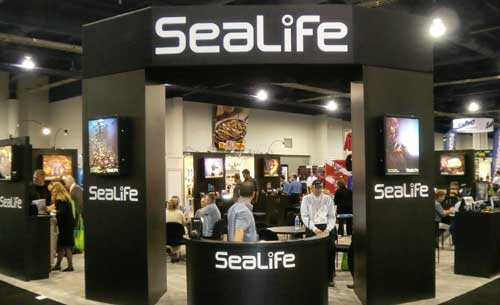
Sony was located in one of the outskirts of the show, demonstrating some of their water housings. Their MPK-THE, MPK-THF, MPK-THG, MPK-WD, APK-THA, and SPK-HCD housings fit a large number of Sony cameras and video cameras. The differentiation here is between Aqty Pack (5 feet), Sports Packs (up to 17 feet) and Marine Packs (up to 132 feet). (sonystyle.com)
I've been covering digital cameras since 1997, but had never come across Intova. Cameras are not their main gig, but I was surprised to see a lineup of inexpensive, elegant underwater cameras, each with their own acrylic housings. Their IC10 and Sport 880 cost less with a deepwater housing than most brand cameras cost without the housing. They also have very cool LED underwater lights.
Another company that we've never had much contact with either via our Digital Camera Magazine nor via ScubaDiverInfo.com is Sea&Sea. They had a major presence at DEMA with an almost dizzying variety of cameras, underwater cases, flashes and tons of accessories. Sea&Sea proudly proclaims itself to be the only company in the world that manufactures only underwater imaging equipment, and their gorgeous and informative 2009 catalog shows their new 12 megapixel cameras with housings as well as their new cases for a number of Nikon and Canon DSLRs and many new lenses, strobes and converters. The catalog also includes extremely useful "system charts" that shows what goes with what. A+ (www.seaandsea.com)
There are people who are good at seeing opportunities out there, like products and little things that are missing or are not done right. The folks at xit404.com are of that ilk. They were not happy with the standard underwater slates because it's so easy to lose the pencil or find the lead broken. So they designed a better one, the Aqua Pencil. They sell it as a kit, in six colors, or as individual pieces: a handy tethered pencil that you twist, a neat slate, a special erase. Great idea. They also make useful bits and pieces for underwater cameras. And are working on an underwater paging system. (www.xit404.com)
At the 500psi booth I saw shelves full of my favorite mask defog. 500psi calls it "simply the best mask defog," and I totally agree and never use anything else. Carol, on the other hand, uses a competing product. 500psi also has the ever popular "Stink Guard," "Salt-Away," Jellyfish sting stop and more. (www.innovativescuba.com)
One of the most attractive divelights I saw was the Fix LED1000 DX by Fisheye. It uses nine high-luminance LEDs for twice the brightness of their previous HG20DX model. The black body is made of reinforced plastic resin, with a corrosion-resistant and elegant silver or burgundy top part. It puts out 1000 lumens and has a 400 foot depth rating. Light output can be adjusted via control dial. (www.fisheye-jp.com)
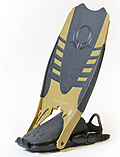 A product that will raise controversy for sure is the Amphibian dynamic scuba fin. It tackles the problem of not being able to walk with fins on with their "Aqua-Hinge" mechanism that pivots the front part of the fin up when you walk. Push on a locking lever to make heavy-duty springs push up the front. Once in the water, simply kick and the blades are flipped down. Looks weird but sounds good. I have never tried them and so don't know how well it works. (www.omegaaquatics.com)
A product that will raise controversy for sure is the Amphibian dynamic scuba fin. It tackles the problem of not being able to walk with fins on with their "Aqua-Hinge" mechanism that pivots the front part of the fin up when you walk. Push on a locking lever to make heavy-duty springs push up the front. Once in the water, simply kick and the blades are flipped down. Looks weird but sounds good. I have never tried them and so don't know how well it works. (www.omegaaquatics.com)
Rebreathers everywhere! Innerspace Systems Corp. showed their latest Megalodon CCR. 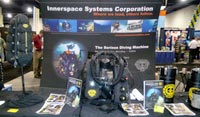 Among their claims to fame are a successful 742 foot dive, full ISO9001:2000 certification, and a commitment to open architecture for integration with other tested systems.
Among their claims to fame are a successful 742 foot dive, full ISO9001:2000 certification, and a commitment to open architecture for integration with other tested systems.
Innerspace also stressed the importance of testing standards and had informative handouts on IEC standard compliance. (www.customrebreathers.com)
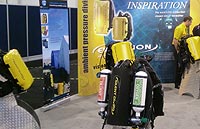 Ambient Pressure was there with their line of Inspiration and Evolution closed circuit rebreathers. Having read so much about the Inspiration and its use by record-setting dives by the late David Shaw, it was fascinating to see and touch some of this advanced technology. (apdiving.com)
Ambient Pressure was there with their line of Inspiration and Evolution closed circuit rebreathers. Having read so much about the Inspiration and its use by record-setting dives by the late David Shaw, it was fascinating to see and touch some of this advanced technology. (apdiving.com)
Poseidon showed the fully automatic Cis-Lunar Mk. VI Discovery rebreather. The claims are substantial: "With Mk VI Discovery you can forget everything you might have heard about scrubber life and oxygen cells, just relax and let the unit handle the controls." The unit weighs 40 pounds, the harness fits any BC, and the unit does a pre-dive test to determine if all is well. (www.poseidon.com)
Speaking of rebreathers, we saw the Frog MK-I rebreather, shown by Ocean Equipment, an MDEA International Company located in Marathon, Florida. This is an impressive and very compact unit available dive-ready, dive-ready without BC, or as just the bare unit.
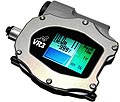 At VR Technology, it was great to see and touch the advanced VRX and VR3 dive computers. These are some of the best and most reliable tech diver computers and the VRX is now available in a military spec version. Also interesting is their variable gradient model algorithm where tech divers can select options to customize the model to their style of diving. (www.vr3.co.uk)
At VR Technology, it was great to see and touch the advanced VRX and VR3 dive computers. These are some of the best and most reliable tech diver computers and the VRX is now available in a military spec version. Also interesting is their variable gradient model algorithm where tech divers can select options to customize the model to their style of diving. (www.vr3.co.uk)
The prize for the most enthusiastic promotion of a dive resort must go to Manta Ray Hotel and Yap Divers. The booth not only showed fantastic underwater ray footage on two big high-res screens, but the dive resort was promoted by a thrilled customer who cannot wait to go back. Her pitch wasn't even a pitch; it was clear that she simply loved that place. Hey, she made me want to change my dive plans and go to the Manta Ray Hotel on Yap instead! (/www.mantaray.com)
It was interesting to walk through the many different aisles dedicated to certain dive locations (like Micronesia below) and talk to the resort representatives. Wouldn't it be nice to visit them all?

Bonaire! We were lucky enough to get invited to the Bonaire Golden Flamingo Award ceremony. Bonaire, of course, is the Caribbean diver's paradise with a Dutch heritage and some of the friendliest and most interesting people anywhere. Bonaire's new marketing highlights the island's people in some terrific posters. The coveted Golden Flamingo Award for:
- top media partner went to Scuba Diver Magazine,
- top travel partner to Andrew Ball of Action Scuba of Middletown, VA, and
- top airline to Delta which started flights from Atlanta and will soon (December 20, 2008) start flights from JFK.
Below are some of the proud winners, standing in front of two of the new Bonaire posters.
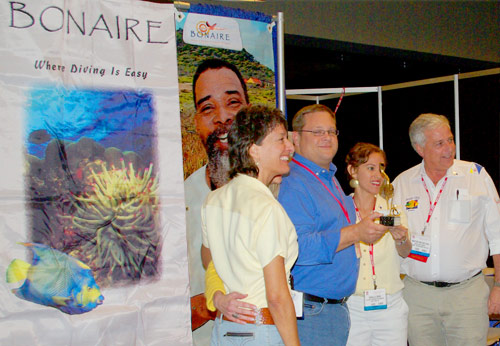
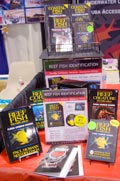 New World Publications showed their famous Reef Fish/Creature/Coral books, courses and DVDs. Not only are those books beautifully done, they're also educational and a lot of fun being able to identify all the critters we see underwater. Carol loves those and has a number of them. (www.fishid.com)
New World Publications showed their famous Reef Fish/Creature/Coral books, courses and DVDs. Not only are those books beautifully done, they're also educational and a lot of fun being able to identify all the critters we see underwater. Carol loves those and has a number of them. (www.fishid.com)
Best Publishing Company was there. They have a complete line of books on diving and hyperbaric medicine, some of which they distribute and some they publish themselves. I had already read many of them and wanted to buy the rest, but that would interfere with my daytime job. I also had a good chat with the owner of the company and I offered him to publish my own book on scuba, but he didn't seem interested. (www.bestpub.com)
We stopped by X-ray mag, the downloadable PDF-based publication we've been reading for years. We talked to Cindy Ross, a contributor and also the owner of GirlDiver.com. The folks at X-ray magazine have had some success in signing up advertisers, but overall, like the rest of us media and content provider types, they're struggling with finding the right combination of print and online technologies to resonate both with readers and advertisers. (www.xray-mag.com)
One of the slogans at the H2Odyssey folks' booth was "more air to spare," referring to the fact many divers like to have a bit more than 1.7 OR 3.0 CUFT of spare air. As a wholesale distributor located in Southern California they carry a complete line of diving gear and accessories. (www.h2odyssey.com)
If you've watched "Sharkwater" you know Captain Paul Watson's Sea Shepherd project. Sea Shepherd was there and we signed up for their e-news mailing list. Watch out for their "Whale War" series on Animal Planet starting November 7, 2008. (shop.seashepherd.org)
Judging by the number of companies selling jellyfish ointments, sprays and other, jellyfish stings must be a big problem. I've personally never had any problems with them, but I am sure this is a product that you do need when you need it. Jellyfish Squish is made by Costal Solutions, Inc. and is supposed to bring significant or total relief within five minutes. (www.coastalsolutionsinc.com)
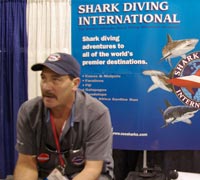 A most interesting encounter was at Shark Diving International. They do shark diving, both with surface cages, deep cages, and swimming. One of the areas CEO Lawrence Groth covers is the Farallones off San Francisco. The Farallones got a lot of attention recently via Susan Casey's book "The Devil's Teeth" (see our review) where the author portrayed Groth in rather negative light. Well, Groth isn't particularly fond of Casey either, accusing her of essentially having killed the place by getting the research team fired. Interesting man, interesting story.
A most interesting encounter was at Shark Diving International. They do shark diving, both with surface cages, deep cages, and swimming. One of the areas CEO Lawrence Groth covers is the Farallones off San Francisco. The Farallones got a lot of attention recently via Susan Casey's book "The Devil's Teeth" (see our review) where the author portrayed Groth in rather negative light. Well, Groth isn't particularly fond of Casey either, accusing her of essentially having killed the place by getting the research team fired. Interesting man, interesting story.
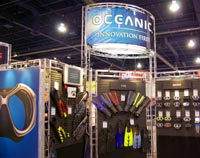 At Oceanic, in addition to their entire 2009 lineup, I saw a high-tech mask that looked just like my own Oceanic DataMask. It was the Aeris CompuMask which seems identical to the DataMask -- not too surprising since Aeris is part of Pelagic Pressure Systems which was started by Oceanic founder Bob Hollis's son Mike Hollis. I had fallen in love with the concept of the DataMask, only to find that it didn't work that well for me. It should be interesting to see where Oceanic and Aeris take the product next. (www.diveaeris.com)
At Oceanic, in addition to their entire 2009 lineup, I saw a high-tech mask that looked just like my own Oceanic DataMask. It was the Aeris CompuMask which seems identical to the DataMask -- not too surprising since Aeris is part of Pelagic Pressure Systems which was started by Oceanic founder Bob Hollis's son Mike Hollis. I had fallen in love with the concept of the DataMask, only to find that it didn't work that well for me. It should be interesting to see where Oceanic and Aeris take the product next. (www.diveaeris.com)
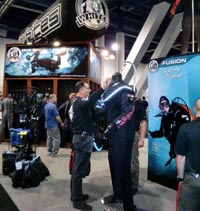 Carol just loved Whites' new line of Fusion dry suits. There is one in red and some have interesting designs on the arm. They also feel different with an abrasion resistant external skin that is very light and stretchy and a DryCORE bladder inside. Available from 2XS to 3XL, and price is around US$1,600. (www.whitesdiving.com)
Carol just loved Whites' new line of Fusion dry suits. There is one in red and some have interesting designs on the arm. They also feel different with an abrasion resistant external skin that is very light and stretchy and a DryCORE bladder inside. Available from 2XS to 3XL, and price is around US$1,600. (www.whitesdiving.com)
As someone who needs reading glasses, prescriptiondivemasks.com caught my eye. They've been addressing this problem for about 15 years. They do single vision, bifocal (for distance and close-up), gauge readers, see-unders and executive readers (larger reading areas). Lenses are glass which doesn't scratch and is better for seeing underwater than polycarbonate. I really should get going and have my Scubapro Frameless mask done. (www.prescriptiondivemasks.com)
Speaking of Scubapro, they weren't there. That is weird for a company of their importance to the industry. As far as I am concerned, it is also not working in their favor as their absence not only makes people wonder what's up with them, but each time they are not there they fade a bit more from the center of people's attention. Hey, almost all my gear is Scubapro, but if I go to the most important event in the dive industry and Scubapro is absent, what does that tell me? And what will I want to buy and recommend next?
DAN, the Divers Alert Network, was there in full force, explaining its educational and referral services that prevent accidents and can save lifes. DAN divers insurance is practically mandatory for any diver and many places won't even let you dive unless you have it. DAN also took orders, and sold their helpful products. (www.dan.org)
 There are a lot of tacky T-shirts out there, but you won't find any of them at Bottom Crawlers. Their high-quality shirts, T-shirts, bottoms, visors and hoodies feature uniformly classy, tasteful and elegant designs on them. They claim that they "create the greatest clothing for the diving world," and that may well be so. What is for sure is that they have the most style and subdued elegance. (www.bottomcrawlers.com)
There are a lot of tacky T-shirts out there, but you won't find any of them at Bottom Crawlers. Their high-quality shirts, T-shirts, bottoms, visors and hoodies feature uniformly classy, tasteful and elegant designs on them. They claim that they "create the greatest clothing for the diving world," and that may well be so. What is for sure is that they have the most style and subdued elegance. (www.bottomcrawlers.com)
Another great source of super-comfortable and useful outdoor and dive apparel is Chammyz. There is nothing like the special all-natural fabric they use in all of their products, and there's nothing like climbing into a pair of Chammyz lounge pants and a Chammyz jacket after a dive (or at home, or outdoors, or just about anywhere). (www.chammyz.com)
If a slate and pencil don't work well for you underwater, check out Trident Dive's US$49.95 aquaSketch underwater writing and drawing system. It's a 3 x 4.5 inch little tablet that can be held or strapped to your wrist.  It contains up to eight feet of waterproof vellum that you can write on. If you need more space to write, simply turn a knob to advance the scroll and get more vellum (over 40 frames). Writing can be erased with a regular eraser. If notes need to be preserved, you can scan them with a Pentax DS mobile 600 portable scanner (package price US$169.95) and then file, email, print or fax them. Very clever, and they even have preprinted vellum with forms, logs, etc. on them. (www.aquasketch.com)
It contains up to eight feet of waterproof vellum that you can write on. If you need more space to write, simply turn a knob to advance the scroll and get more vellum (over 40 frames). Writing can be erased with a regular eraser. If notes need to be preserved, you can scan them with a Pentax DS mobile 600 portable scanner (package price US$169.95) and then file, email, print or fax them. Very clever, and they even have preprinted vellum with forms, logs, etc. on them. (www.aquasketch.com)
Energizer was there to promote their Energizer Ultimate Lithium AA and AAA batteries. That's the kind that feels different when you hold them in your hand because they weigh a lot less than standard alkalines. They also last up to eight times longer in digital cameras, they do not discharge even after years, they can handle extreme temperatures, and though they cost more, there are situations where nothing else will do. (www.energizer.co)
When you want to keep stuff dry, one of the companies that comes to mind is Pelican. They showed the part of their lineup most appropriate for divers: waterproof flashlights and all sorts of cases. I love their micro cases in "adventure series" colors -- colorful plastic bottom, clear acrylic top so you can see what's in it. One peculiar thing was a water tank full of their flashlights. It showed they don't leak, but at a diver's convention, showing that a divelight doesn't leak in two feet of water doesn't seem to make much sense. (www.pelican.com)
Dive gear is heavy and bulky, and getting it from a parking lot or hotel room to the beach or the dive boat can be a big pain. If you're sick and tired of making multiple trips or starting a dive already exhausted, the folks at Beach Buddy have a novel solution. It's an ingenious little wheelie cart that holds all your gear, including tank. You then roll the whole lot to and into the water, inflate the BC so the everything floats, put your gear on, pop off the wheels, stow them in the collapsible Beach Buddy which now just adds a bit of length at the bottom of your tank, and off you go. Sounds weird, but looks like it could really come in handy. (www.beachbuddy.com)
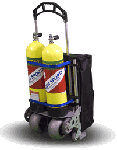 Another solution to moving dive stuff around is the adventure cart by Smart Gear. At US$399 is a bit pricey, but you can use it to roll around two scuba tanks and a whole lot of gear in a collapsible, heavy-duty all-terrain cart. (www.smartgearusa.com)
Another solution to moving dive stuff around is the adventure cart by Smart Gear. At US$399 is a bit pricey, but you can use it to roll around two scuba tanks and a whole lot of gear in a collapsible, heavy-duty all-terrain cart. (www.smartgearusa.com)
Speaking of stowing gear, Stahlsac was there and showed off its unique lineup of watersport luggage. Here at scubadiverinfo.com we've been using Stahlsac mesh bags for many years. We've yet have one break or rip despite the abuse we subject them to. Great stuff. (www.stahlsac.com)
While most divers never need to lift anything underwater more substantial than themselves, for professional and serious hobby divers lift bags are tools for the job. Carter Lift Bags has been in that business for 35 years and they showed their entire lineup, from sausages and personal floats all the way up to massive salvage tubes and open bottom lift bags with 12,000 pound lift capacity. All of their bags have handles and tie-off points, can be folded into easy-to-handle negatively buoyant packages, and have over-pressure valves. (www.carterbag.com)
An area of the show floor that I really enjoyed was the New Products Showcase where a selection of the best and coolest new dive gear and innovation was displayed. It was very well done.

After two full days of nothing but walking around the show floors and enjoying all the cool new dive gear we were pretty pooped. Realize that the above list of interesting products does not even cover one tenth of all the exhibitors! That's how big DEMA 2008 was.
On the way back from Las Vegas to our offices near Sacramento, Calif., we drove through Death Valley. It's an awesome drive and I can now say that I was at 282 feet, on air. Yes, the lowest point of Death Valley is 282 feet below sea level.
Report by Conrad H. Blickenstorfer; photography by Carol
Cotton








